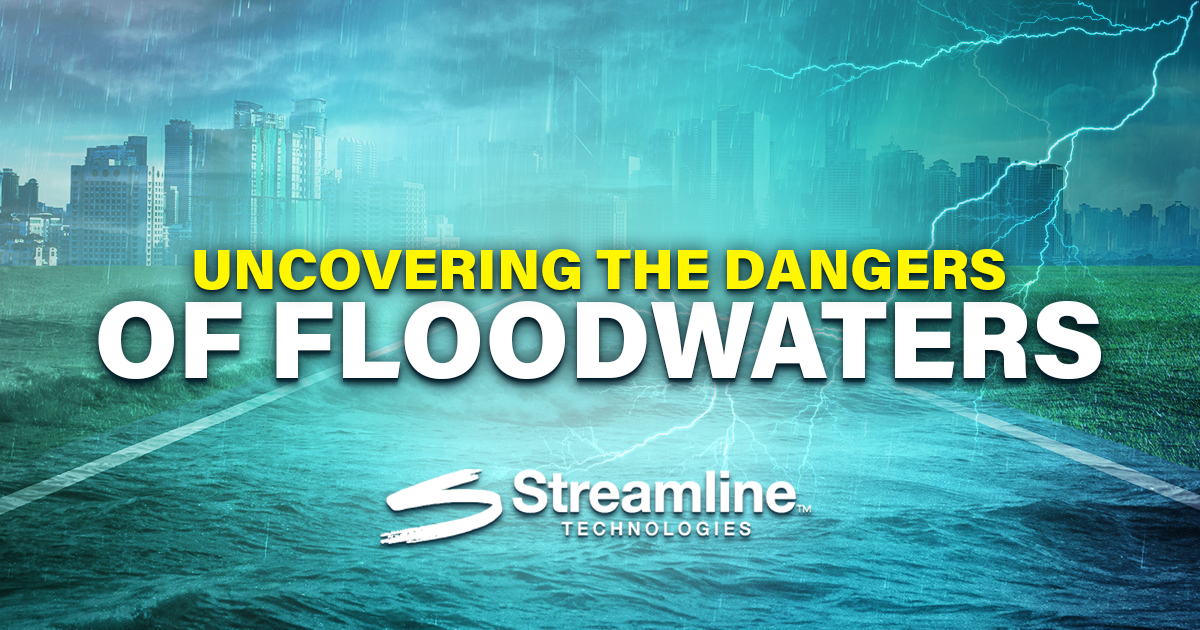Floodwater can occur as a result of heavy rains, storm surges, dam or levee failure, and more.
However, the risks associated with floods often go far beyond physical damage alone.
In the aftermath of a powerful storm, floodwaters can often wreak havoc on the communities left in their wake as the risks associated with these waters go far beyond just visible destruction. As water accumulates as a result of storms, dam failures, or other sources, it becomes a breeding ground for numerous threats to human health. These threats can include dangerous bacteria, viruses, harmful chemicals, debris, downed power lines, and even encounters with wild animals.
Understanding the extent of these risks is crucial to ensure the protection of ourselves and our communities. Plus, with continued climate variability, the frequency of flooding is rising worldwide, leading to an escalation in these associated risks and threats.
“We can no longer rely on historical or anecdotal records for the maximum possible flood depths. A supercell, high-rainfall tropical storm, hurricane, or atmospheric river can mean that water levels in your neighborhood ponds, streets, and canals reach new levels far beyond the modeled 100-year storm event. Unfortunately for many of my neighbors, this meant inches of water inside their homes during Hurricane Ian.” Heather L. Brady, P.E.
Discovering Hidden Dangers
While the visible damage caused by flooding may grab our attention, did you know it’s the unseen hazards lurking within floodwaters that often pose the greatest risk? These waters often become a breeding ground for dangerous pathogens originating from sewage overflows due to overwhelmed water-management systems, bacteria carried in by natural water sources, and so much more - putting anyone who comes into contact at risk of these hidden dangers.

And whether you find yourself in a bustling city or a peaceful countryside, flooded areas can also become contaminated by various chemicals that are typically isolated from human exposure, such as motor oil, cleaning chemicals, and pesticides or fertilizers.
"The smallest materials in floodwaters can be the most dangerous," says Henry Briceño, a Florida International University Geologist. “The problems are things that, many of them, you don’t see,” he says, citing in particular the pathogens and chemicals that can accumulate in floodwaters.
Bartels, M. (2023, August 30th). What's In Floodwaters? Scientific American. https://www.scientificamerican.com/article/whats-in-floodwaters/
Understanding the Physical Dangers
Beyond pathogens and bacteria, however, communities experiencing floodwaters should also be aware of larger physical dangers present during flooding. Downed power lines can pose electrifying dangers in flooded areas, while submerged debris such as tree limbs can also harm those who attempt to navigate these waters.

Additionally, floodwaters can carry an array of wildlife, with animals such as fire ants, snakes, reptiles and rodents being displaced from their homes and in search of shelter from the storm. When these waters linger, communities can also fall victim to substantial increases in the mosquito population and the pathogens that these insects may carry with them.
Flooding - A Global Threat
The dangers of floodwaters are consistent globally, prompting emergency responders to strongly advise the avoidance of these waters whenever possible. And while it may not always seem feasible to stay away from floodwaters during evacuations or thereafter, experts caution against underestimating the hazards associated with flooded areas and urge adequate preparation.
“Flooding comes in all forms—it’s not just restricted to our coastal areas. We see it inland, in low-elevation areas as well as high-elevation areas,” says Thomas Frazer, an Ecologist at the University of South Florida. “The general problem is geographically agnostic.
Bartels, M. (2023, August 30th). What's In Floodwaters? Scientific American. https://www.scientificamerican.com/article/whats-in-floodwaters/
Regardless of location, it’s important to not underestimate the dangers of flooding. It can happen anywhere, not just along our coastlines or major rivers. Whether you're near the next significant rainfall storm event or miles away, it's crucial to be prepared. Flooding does not discriminate based on geography as it affects both low and high-elevation areas. So, stay informed and be prepared for anything.
“With FloodWise, the predictive tools can help communities prepare for floods knowing where it may be necessary to floodproof homes with sandbags, evacuate residents, relocate vehicles to prevent flood damage, and determine potential road closures due to flooding. In addition, FloodWise can be used to prepare for recovery efforts by placing resources in the right place at the right time following significant storm events.” – F. Warren McKinnie, P.E., CFM, GISP
Contact our team today to learn how Streamline Technologies’ FloodWise (formerly RTFF) modeling service can accurately forecast flooding several days in advance to help your community take a more proactive approach to floodwater management.
TAGS
Blogs